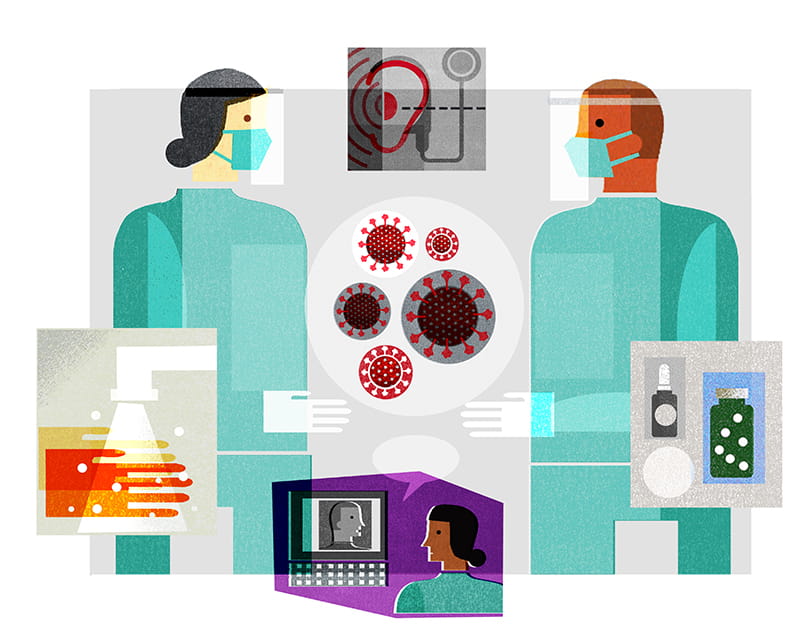
2020 Annual Report
 When it comes to airway management at a large medical center, it takes a multipronged approach to ensure caregivers at all levels have what they need to be successful.
When it comes to airway management at a large medical center, it takes a multipronged approach to ensure caregivers at all levels have what they need to be successful.
Minka Schofield, MD, associate professor in The Ohio State University Wexner Medical Center Department of Otolaryngology – Head and Neck Surgery, has made it her mission to reduce sentinel events related to airway emergencies or difficult airways.
As chair of the ENT Quality Improvement Committee, Dr. Schofield and her team identified airway safety as a focus for the group. As a result, medical center policies involving multiple disciplines, including anesthesia, acute care surgery and pulmonology, were developed.
Their work is standardizing care of tracheostomy patients. It has also established a new protocol for triggering an airway response team, created an “Airway Alert” banner notification in the electronic record and built education via computer-based learning modules. Teams are now working to fully deploy these interventions and measure success.
To standardize the airway management for patients with a tracheostomy tube or total laryngectomy, a medical center-wide Tracheostomy Postoperative Care Policy has been introduced.
The policy outlines specific care standards, provides troubleshooting guidelines and contains clear discharge plans for these patients.
The policy also includes a sign protocol — a visual cue to be placed at the head of the bed of patients with a tracheostomy tube or total laryngectomy. This sign is intended to provide code blue or emergency response teams entering the room with an immediate alert to the type of airway they’re dealing with.
The sign protocol portion of the policy is being piloted within The Ohio State University Comprehensive Cancer Center – Arthur G. James Cancer Hospital and Richard J. Solove Research Institute and will soon be expanded across the medical center.
Airway emergencies require quick intervention. A collaborative effort between anesthesia, ENT, acute care surgery, pulmonology and other emergency response team representatives has been developed to speed care to patients with an airway emergency or difficult airway.
Called Difficult Airway Response Team (DART), the collaborative operates similar to a code blue response. When an airway emergency requires swift intervention, a page is sent to the services involved in DART. This page triggers the rapid mobilization of team members who can quickly assist.
“DART was designed to reduce the delay in securing an airway and, ultimately, to reduce the risk of brain injury or death,” Dr. Schofield, assistant professor - clinical at the College of Medicine says.
DART was fully deployed in September 2019 and work continues to ensure this intervention is operating efficiently and called upon appropriately.
In March 2018, an Airway Alert banner was added to the Epic electronic medical records system. The banner is initiated when a caregiver associates specific medical codes with the patient. If related codes are entered, the alert banner is triggered. All providers working within that patient’s chart see the banner and are alerted to a potential airway issue.
The banner allows for direct communication with others on the care team.
“If you’ve worked with a patient and know they need a specific size tube or fiberoptic scope for intubation, for example, these notes can be added to the banner so others are made aware and time isn’t wasted,” Dr. Schofield says.
The banner also plays a key role in the policy associated with DART.
“Within the DART policy, only credentialed airway providers should trigger the response,” Dr. Schofield says. “But if there is an Airway Alert banner in place for a patient, any provider can trigger a DART. The banner serves as an OK to call in the troops for help.”
The key to long-term success of the airway interventions put in place across Ohio State Wexner Medical Center, Dr. Schofield says, is making sure medical staff and providers have the right level of education to manage these patients.
“To understand where things stood, we distributed an educational needs assessment across the medical center,” Dr. Schofield says. “The results are now being used to identify targeted areas to improve training or create specialized education.”
Dr. Schofield has also developed a three-part tracheostomy computer-based learning module. The training, which will be distributed based on the needs assessment findings and work location, will reinforce the standardized protocols in place for airway management.
“All of the interventions that have been put into place — the policy, DART, the Epic banner and education — are designed to work together to prevent care delays and raise awareness among the primary care teams and emergency responders as it pertains to the patient’s airway and management,” Dr. Schofield says.
Patient safety remains a paramount priority across all disciplines at Ohio State Wexner Medical Center – especially with patients experiencing airway emergencies. The multipronged approach to training and educating multidisciplinary teams ensures the necessary steps are in place to positively impact patient safety and outcomes.